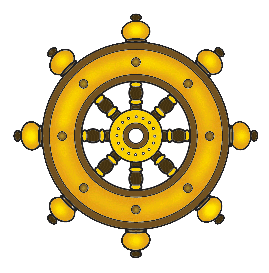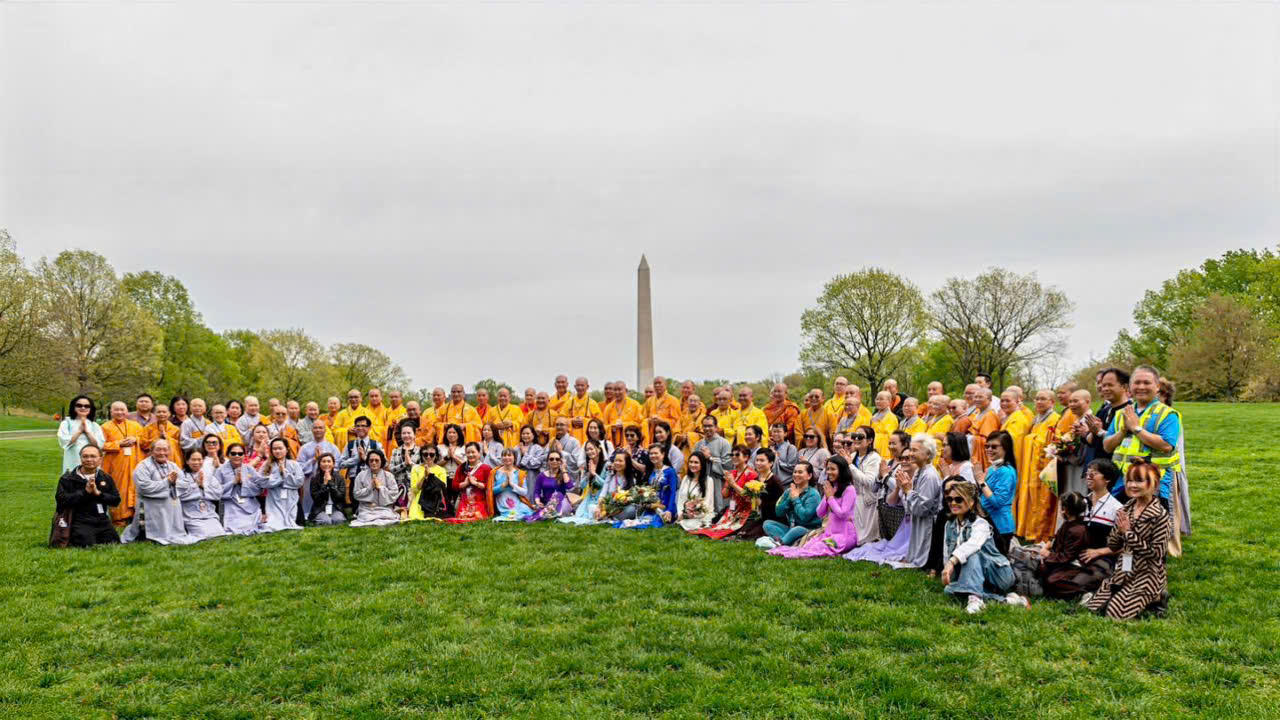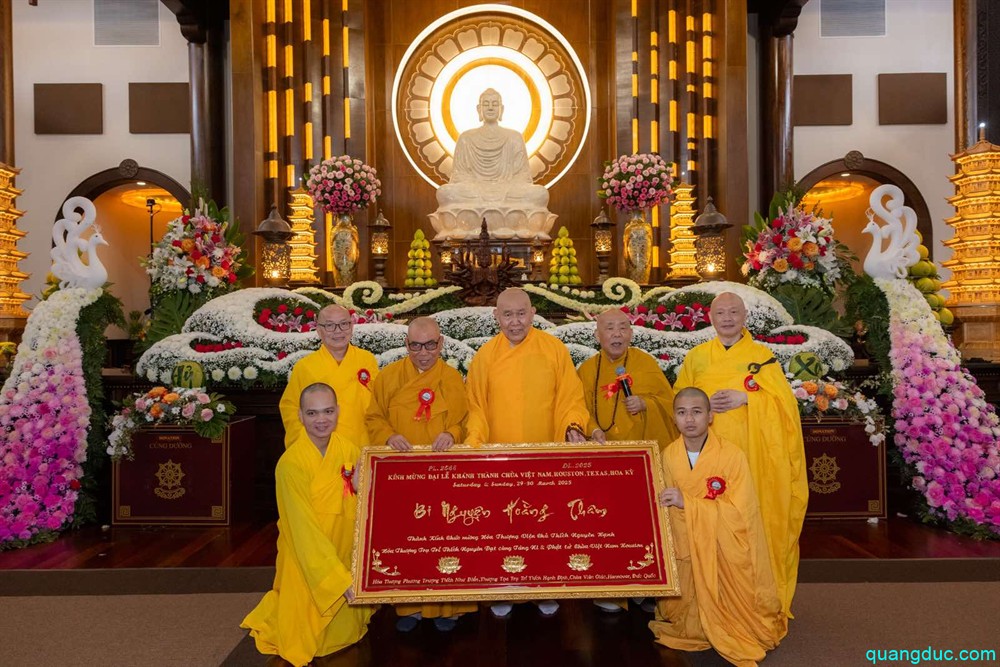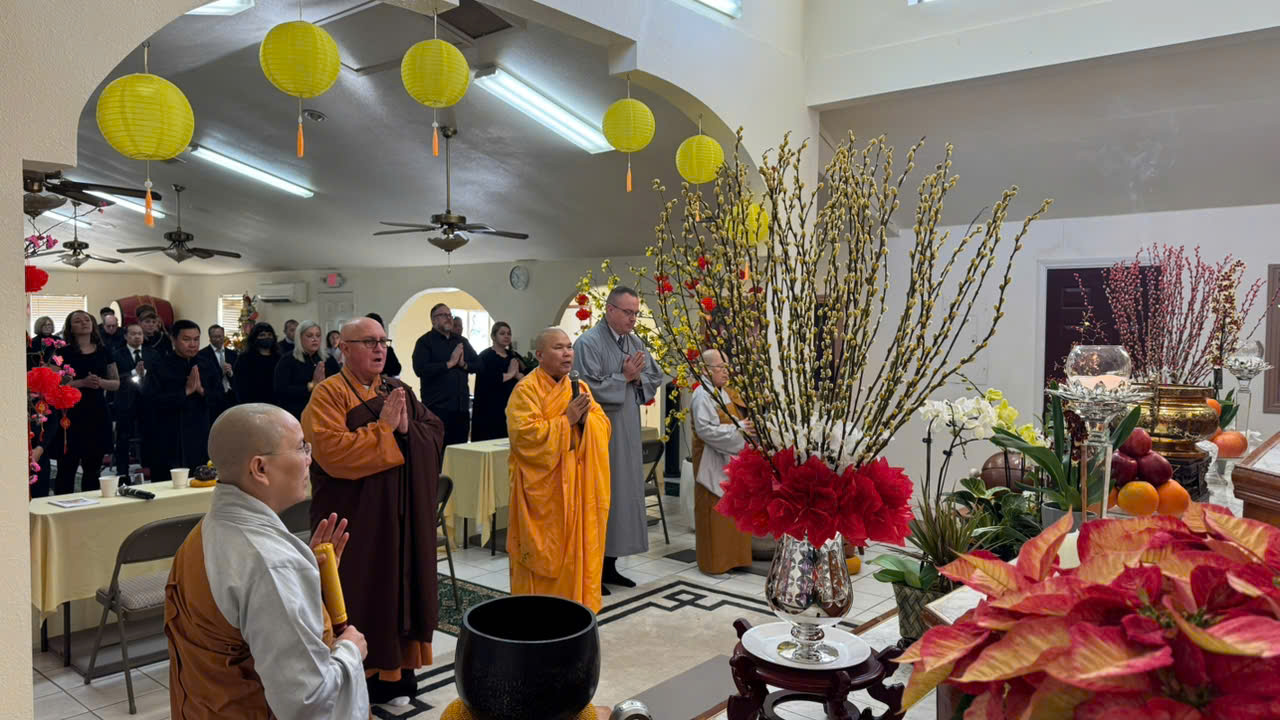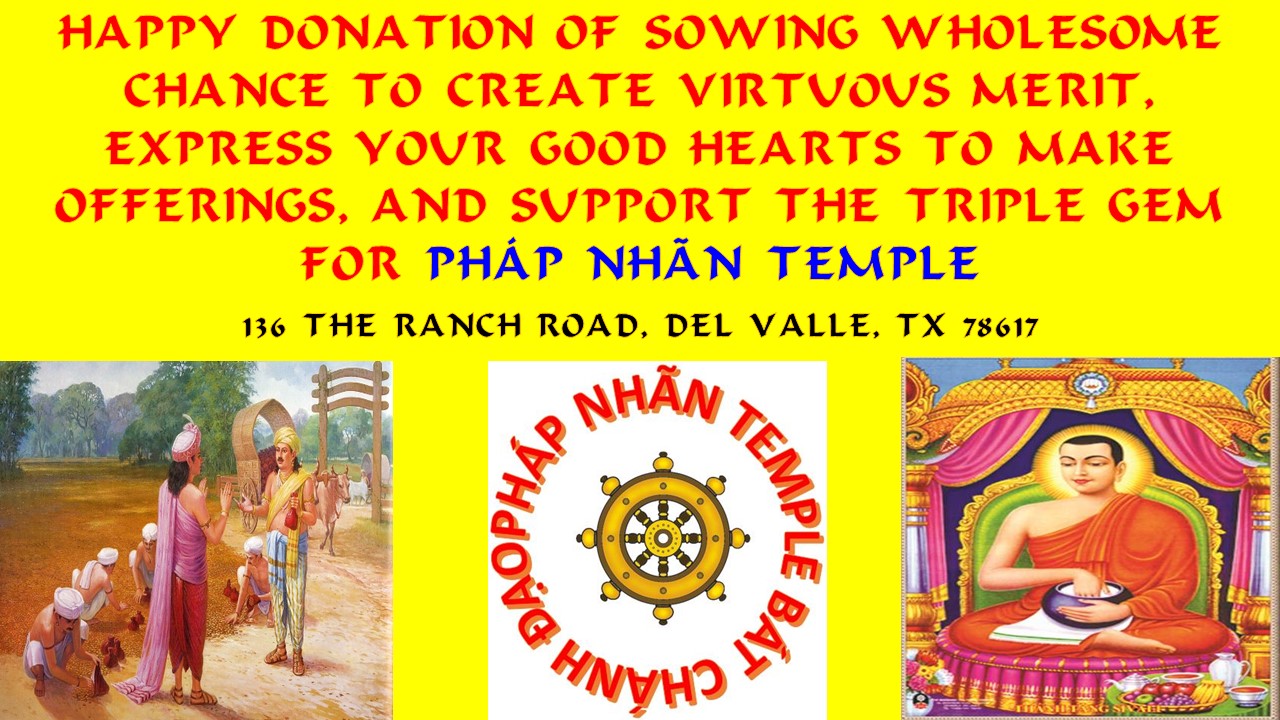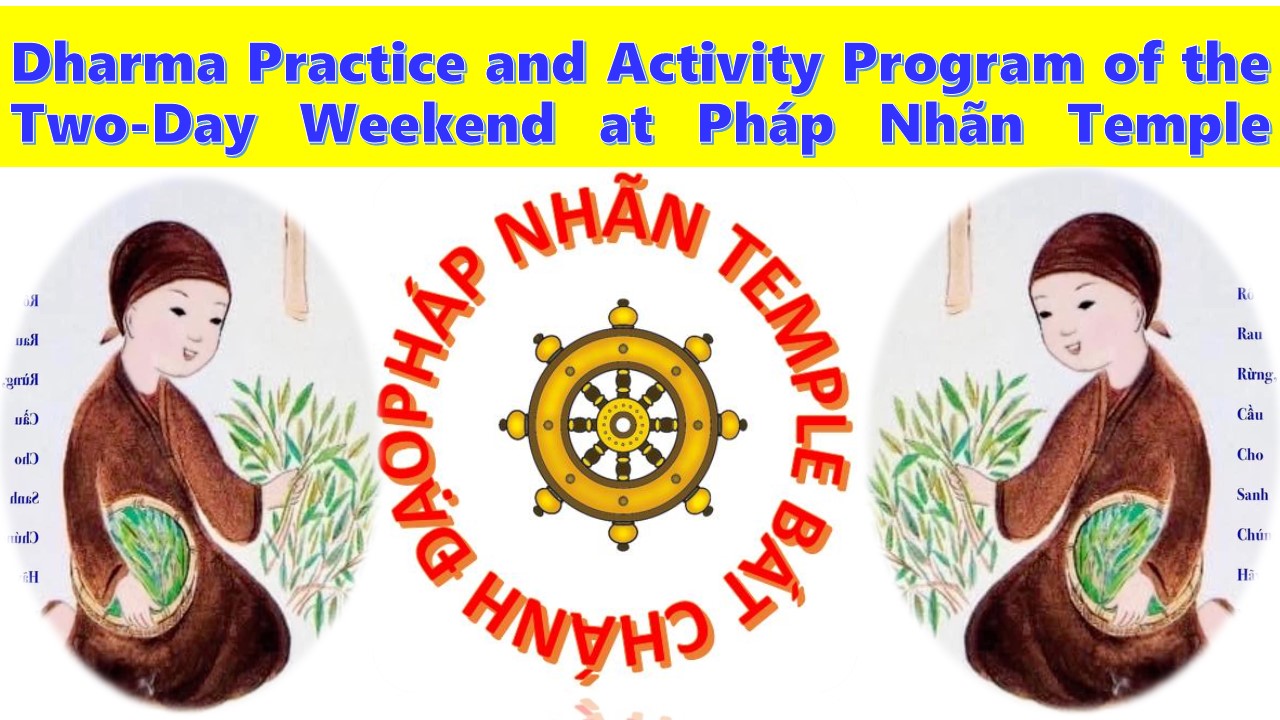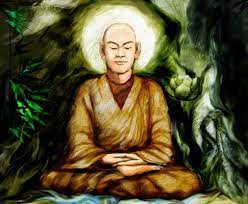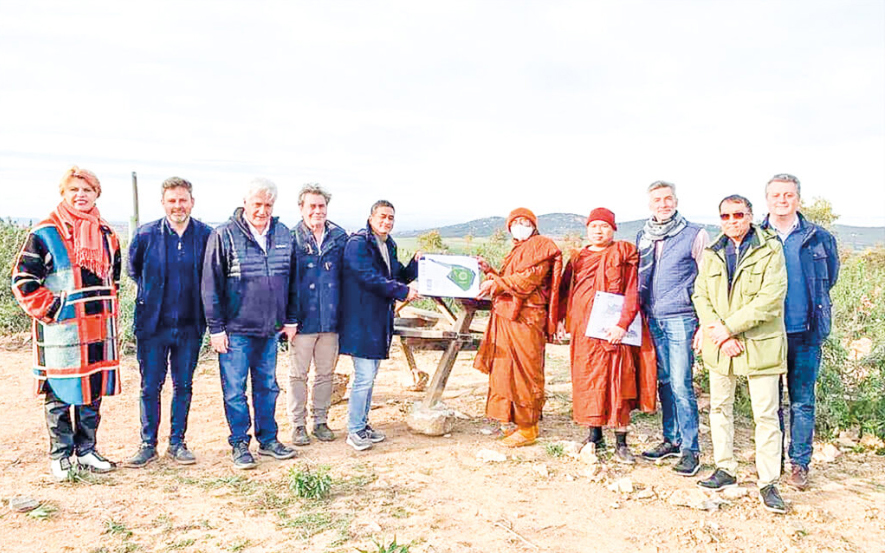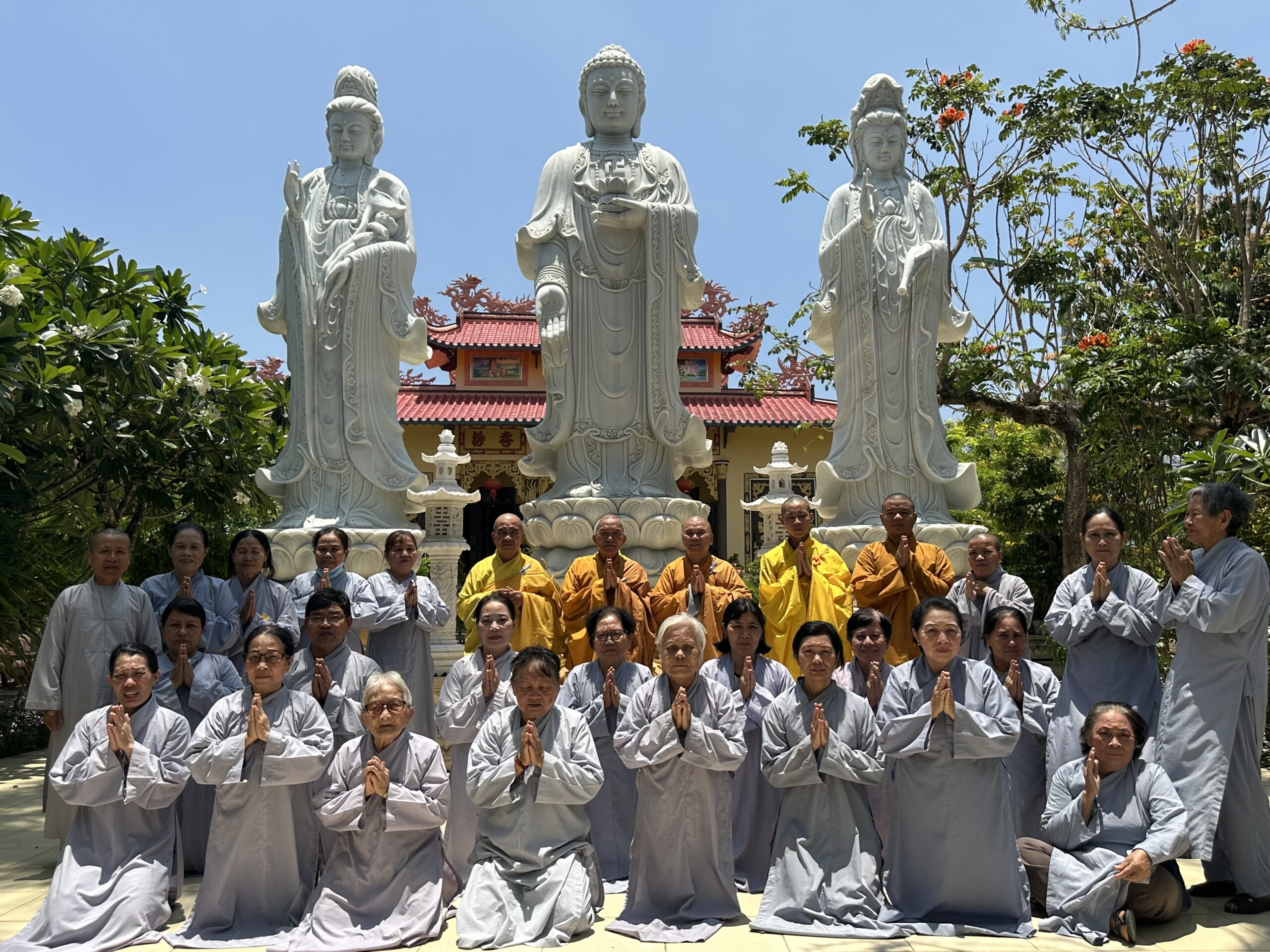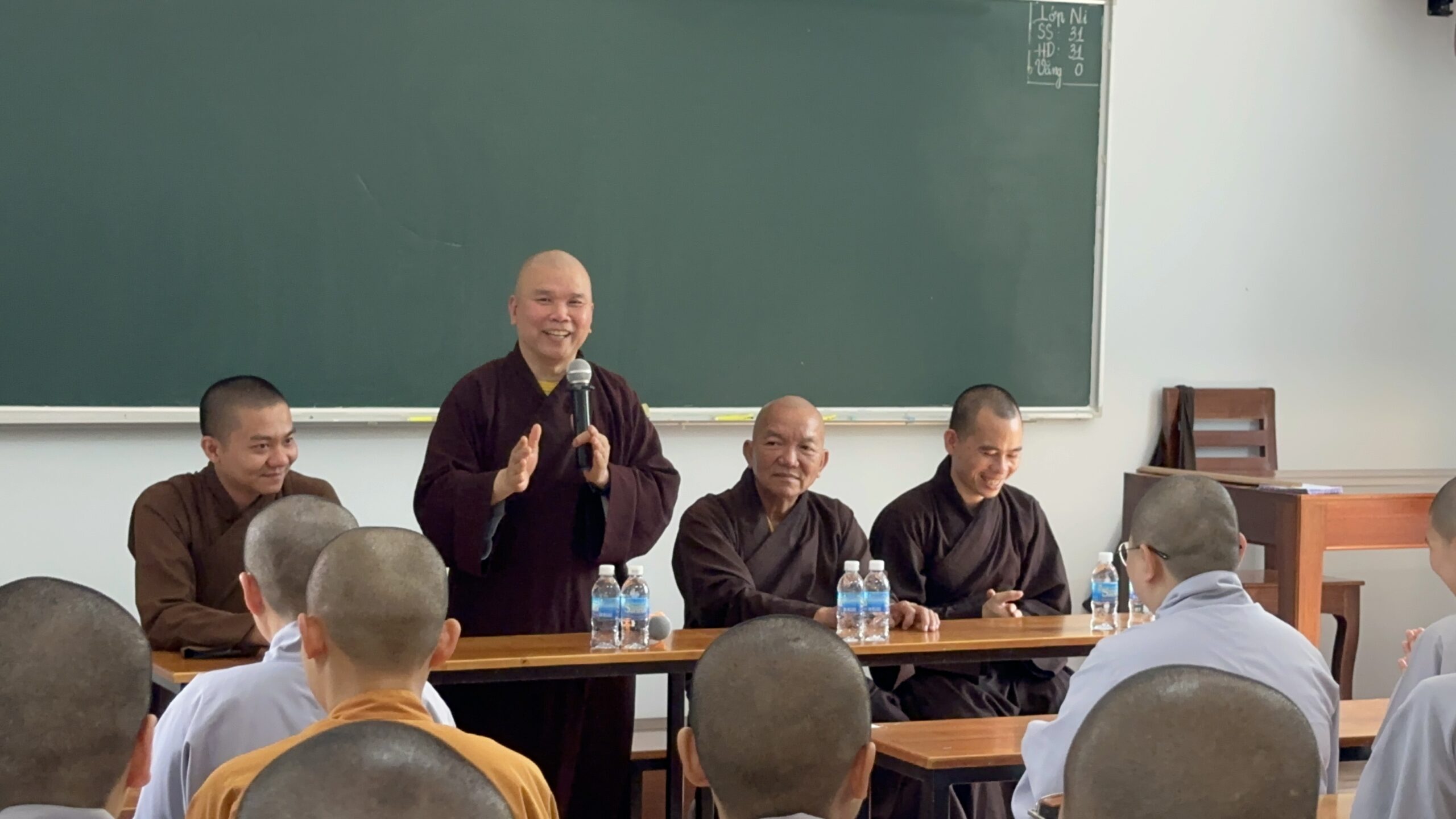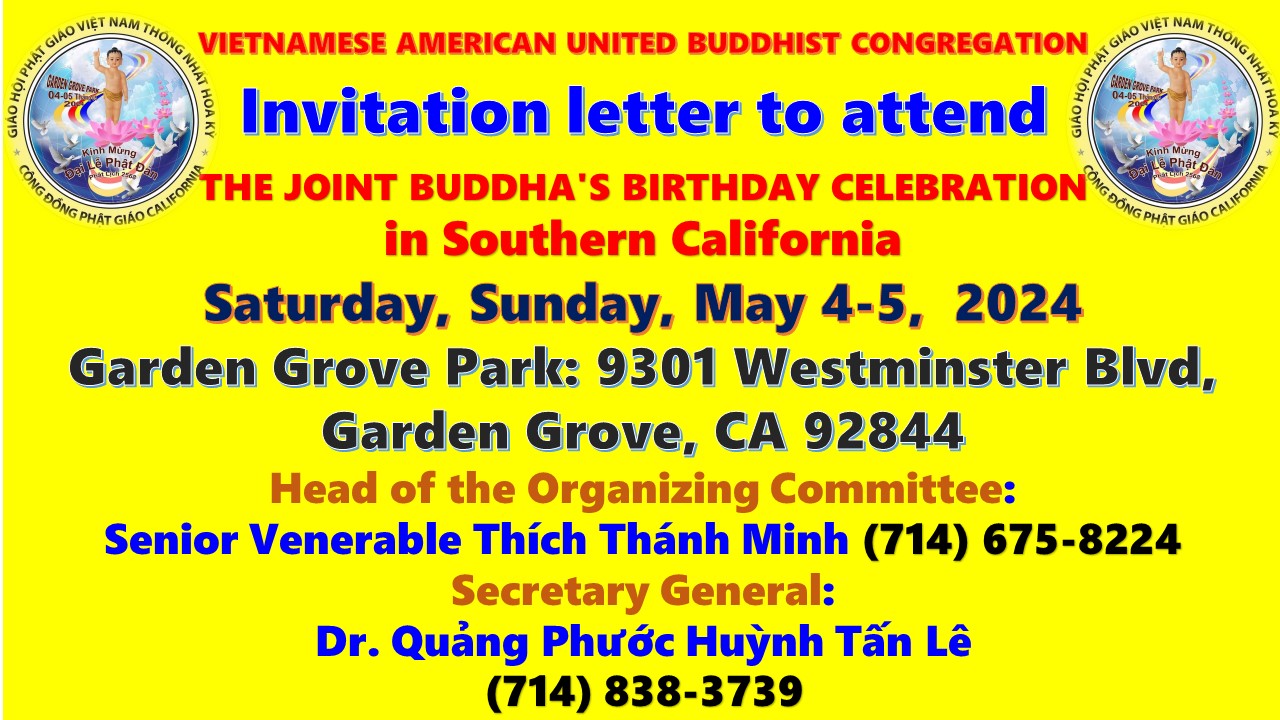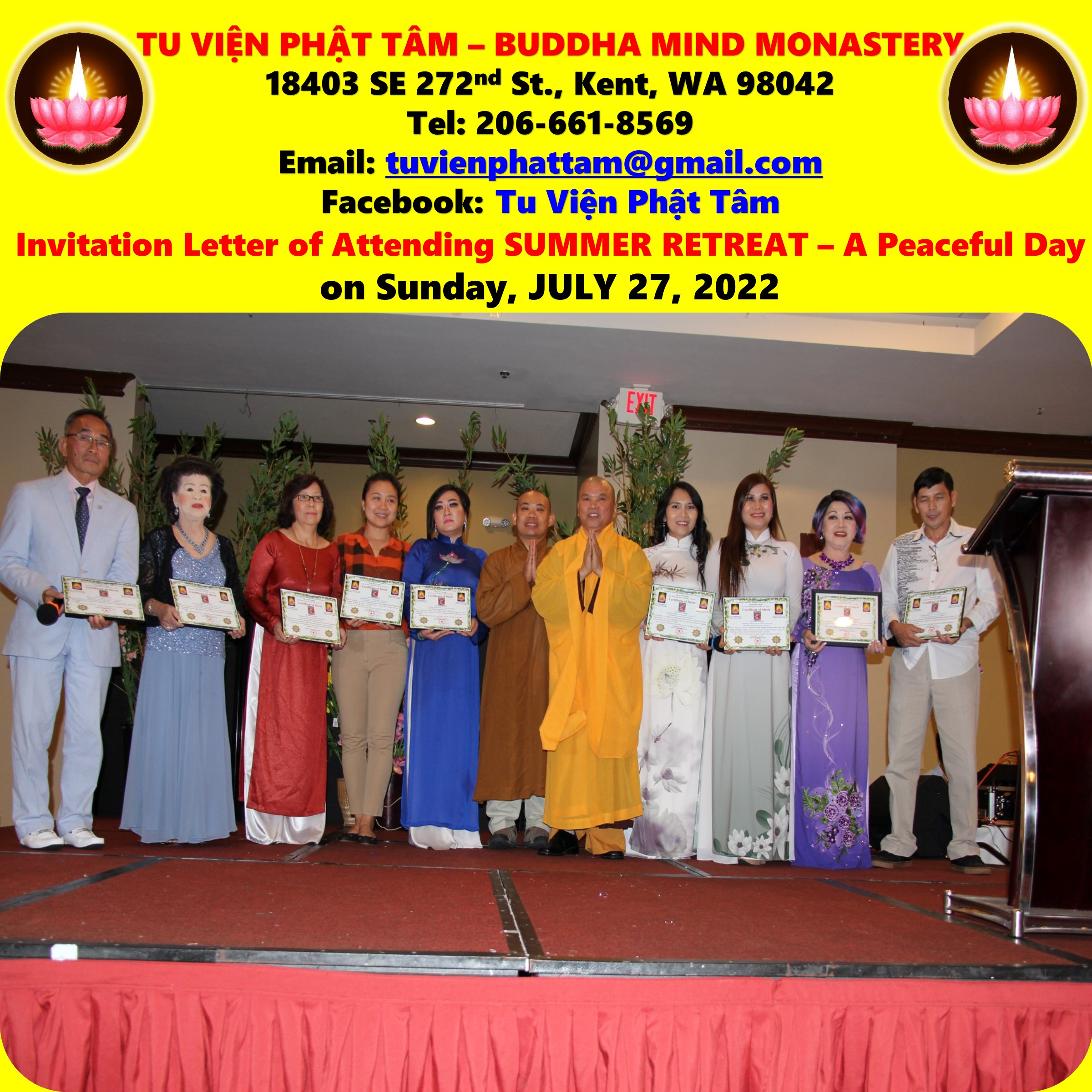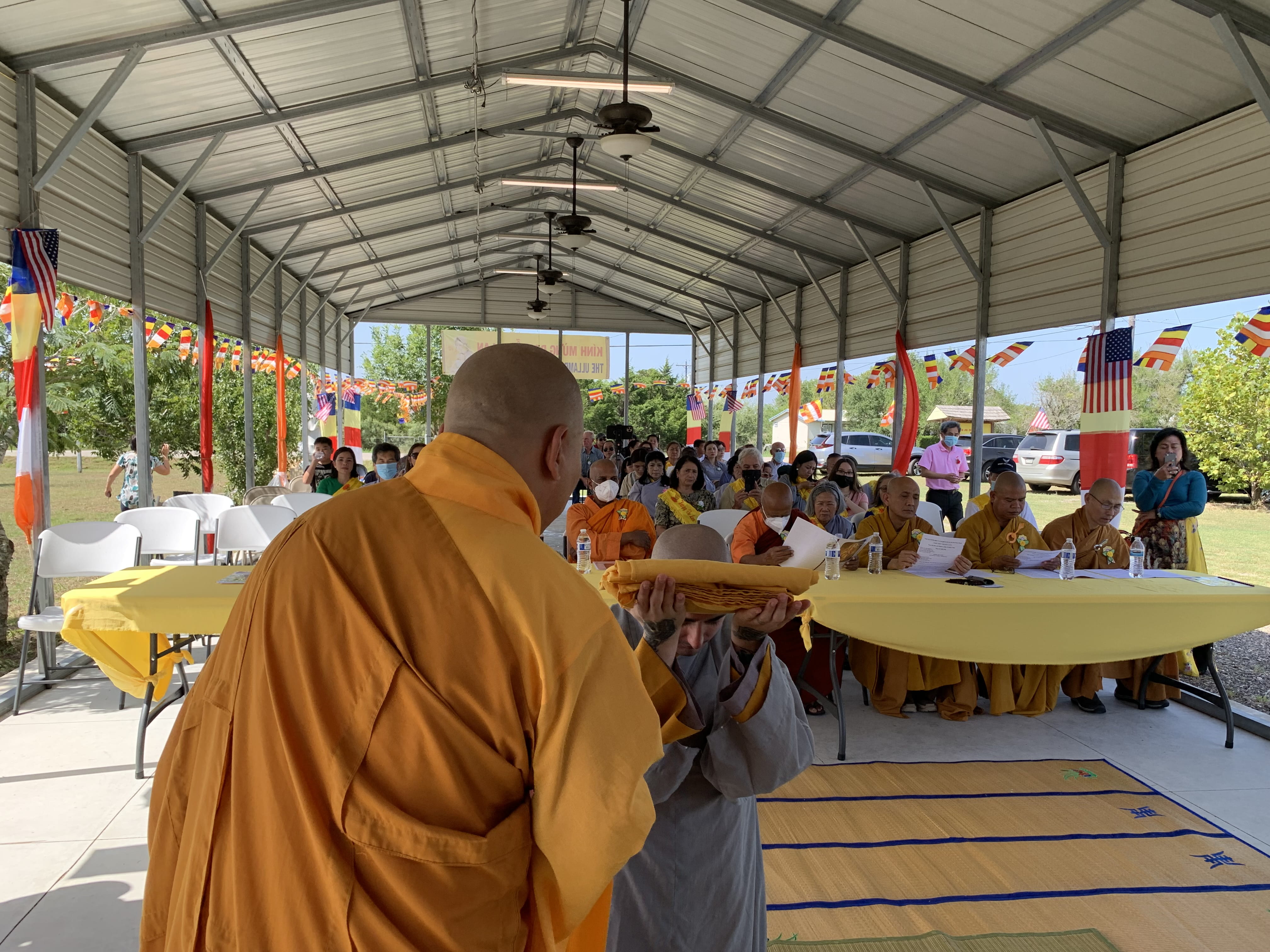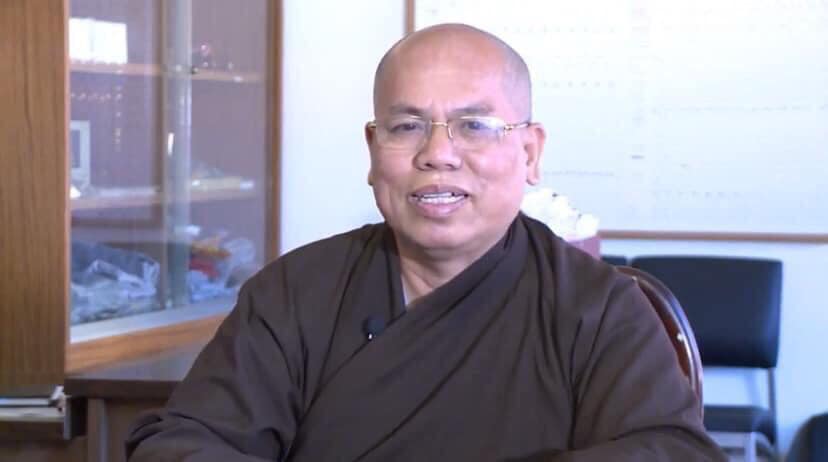
BIOGRAPHY VENERABLE MASTER THICH NHU MINH
I. FAMILY
Most Venerable Thich Nhu Minh, whose world name is Huynh Phac, was born on the 27th day of the 6th month of the lunar Year of the Horse (1954), at the white sand beaches of Nha Trang, Khanh Hoa province to a devoted Buddhist family. His father is Mr. Huynh At with the Dharma name Như Khai, and his mother is Mrs. Le Thi Xich, Dharma name Nguyen Xuan.
II. CHILDHOOD
Venerable Nhu Minh was raised in the love of his parents, and when he finished his first class of elementary school, they left their hometown to live in the wild highlands of Quang Duc province; today Daknong province. His family had a house with wooden walls and thatched roof with rattan leaves in Sung Duc commune. Later the next year they moved to a new house in Kien Tin commune, Kien Duc district. The following year (1960) Venerable Master’s family came to settle down in this land, where they still live. Near his house, there was a pagoda called Liên Hoa (Lotus Flower) located on a beautiful hillside, where the Venerable Master Thich Tri Huy (as the Proved Master, Chief Representative of Buddhism in Quang Duc Province, Abbot of Phap Hoa Pagoda, the provincial headquarters of Buddhism) lived and spread Buddhism. Venerable Master Thich Tri Huy was ordained by Patriarch Hoang Thac at the Sac Tu Thach Son Temple in Quang Ngai, a co-teacher with Elder Chon Giam Dao Quang Tri Hai (1876 –1950), the editor of Tu Bi Am Buddhist magazine. In 1958, he left Pho Quang Pagoda in Quang Ngai to Quang Duc to establish Phap Hoa Pagoda. Venerable Master’s father took refuge with the Venerable Elder Monk and became a member of the Representative Board of Lien Hoa Temple. As a child, Venerable Như Minh often followed his parents to the temple every fortnight, in addition to attending festivals to worship Buddha and recite sutras. Thanks to such a predestined relationship, Venerable Nhu Minh followed the ideal path of Buddhism under the guidance of Master Trí Huy.
III. MONASTIC EDUCATION
In the Mouse Year (1965), Venerable Nhu Minh was accepted as a monastic disciple by the Most Venerable Chon Bich Dao Lien Tri Huy (1917–1970) bestowed the Dharma name Nhu Minh. In the summer of 1967, after two years of diligent study and practice as a young novice, Rev. Nhu Minh was ordained by the Most Venerable Master Tri Huy and officially entered the Tao Khe stream of Buddhist Order and became a member of Phap Hoa Pagoda. In the Rooster Year (1969), on the occasion of the Enlightenment Day of Bodhisattva Avalokitesvara, Rev. Nhu Minh received the Ten Novice Precepts ordination ceremony under his Elder, Most Venerable Master Tri Huy. But unfortunately, half a year later, Master Tri Huy passed away on the afternoon of the first day of the lunar year, the Dog Year, in 1970. In 1970, Venerable Nhu Minh completed four years of Middle School at Quang Duc High School. Because this province did not have a high school level, he had to move to the neighboring province of Dak Lak to study at Ban Me Thuot General High School. Here, Venerable Như Minh was admitted to live at the Sac Tu Khai Doan Pagoda by the Venerable Abbot Thich Quang Huy. After passing the baccalaureate exam in 1974, Venerable Như Minh attended the Faculty of Buddhism at Van Hanh University in Saigon. The President of Van Hanh University is the Most Venerable Thich Minh Chau. In the same year, Venerable Nhu Minh studied at the Eastern Philosophy Faculty at Van Khoa University in Saigon. The Vietnamese historical event on April 30, 1975 happened, and the Government of the Vietnamese Republic dissolved the universities, including Van Hanh University, which was closed. Therefore, a year later, the president of Van Hanh University decided to move Van Hanh University to a new address at 716 Vo Di Nguy street, the 4th Ward, Phu Nhuan District, Saigon. Venerable Như Minh followed the instructions of President Thich Minh Chau and the Venerable Bhikkhuni Thich Nu Tri Hai (Head of Van Hanh University Library) to transfer the entire Buddhist Library to the Van Hanh Institute of Buddhist Studies. Here, the Venerable President directed the major in Buddhist studies and continued to translate and print sections of the Pali Canon (two sets of the Collection of Long Discourses (Pali: Dīghanikāya) and the Collection of Middle Length Discourses (Pali: Majjhima Nikāya) at Van Hanh University, the Chinese Tripitaka, Buddhist research, Vietnamese Buddhist history, authoring, translating, and teaching Buddhist Studies to student monks and nuns and lay Buddhists. In the Dragon year (1976), Ven. Nhu Minh paid homage to the Most Venerable Thich Minh Chau whose titled Tam TriVien Dung Minh Chau (1918-2012), the High Priest, the Heart of the Law, became the teacher of Ven. Nhu Minh. Master Thich Minh Chau agreed and gave him the Dharma name Nguyen Khong and sent Ven. Nhu Minh to ordain him with the Bhikkhu precepts at the Quang Duc ordination ceremony at An Quang Temple in January 1977. It was the first ordination ceremony organized by the Unified Buddhist Church of Vietnam since 1975. The precept masters in the ordination consisted of the dignified and virtuous monks: the Elder Venerable Thich Tri Thu (the president), the Elder Venerable Thich Hanh Tru (the nest leader), the Elder Venerable Thich Don Hau (the lawyer), the Elder Venerable Thich Mat Hien and the Elder Venerable Thich Thien Tuong (the instructors/ teachers).
IV. STUDYING DHARMA
After being ordained as a new bhikkhu under the tutelage of the Elder Venerable Minh Chau at the Van Hanh Institute of Buddhist Studies, Ven. Nhu Minh took refuge from his Master to study the way, consult and study the scriptures, and practice the precepts and stateliness. At that time, Ven. Nhu Minh was one of six members on the director’s board of Van Hanh Institute of Buddhist Studies. Every day, in addition to his work as a librarian at the Van Hanh Buddhist Library, he joined the class to learn the Collection of Middle-length Discourses (Pali: Majjhima Nikāya), the Pali language and Buddhism in English (taught by President Thich Minh Châu), Sanskrit (instructed by the Most Venerable Tri Sieu), and Buddhism (guided by the Most Venerable Tue Sy). The Buddhist studies program was long-lasting and continued until the spring of 1984.
V. SHARING DHARMA
As a monk, spreading the Dharma is a noble aspiration. Therefore, Venerable Nhu Minh always remembered the Patriarchs’ teachings of taking the Buddha’s compassion and wisdom to nurture his own bodhi mind for the peace and happiness for himself and others in this life. In order to fulfill that wish, Venerable Nhu Minh diligently studied for many years the Canon scriptures (translated into Vietnamese from Pali by his master, Thich Minh Chau) and Mahayana sutras such asthe Lotus Sutra (Sanskrit: Saddharmapuṇḍarīka-sūtra), Nirvana Sutra, and the Flower Ornament Scripture (Sanskrit: the Avatamsaka Sutra), and the Diamond Sutra (Sanskrit: Vajracchedikā Prajñāpāramitā Sūtra), and so on. In the Rooster Year (1981), Ven. Nhu Minh was invited by the Board of Directors to be a teacher of the ancient Pali language for the student monks and nuns at the Intermediate Buddhist School at An Quang Pagoda and the Primary School of Buddhist Studies at Giac Ngo Temple. In the same year, the Most Venerable Abbot Thich Minh Chau instructed Ven. Nhu Minh to assume the position of administrator of the Van Hanh Institute and to restore its buildings. In 1989, under the instructions of the Venerable Most Thich Minh Chau, Ven. Nhu Minh carried out the construction of a new three-way gate of Van Hanh Zen Monastery. In 1989–2001, as a chief librarian of the Library of Buddhist Studies, Vietnam Institute of Buddhist Studies, Ven. Nhu Minh edited and printed a number of books on Buddhism and the history of Buddhism in Vietnam. In 1990, following the instructions of the Venerable Elder Thich Minh Chau, Ven. Nhu Minh directed the construction of the Patriarch’s building and the lecture hall of Van Hanh Zen Monastery. In 1992, the Phap Lac stupa of the Elder Venerable Master Abbot Thich Minh Chau at Van Hanh Zen Monastery had been built in accordance with the ideas of the sangha at Van Hanh Institute. In 1995, Ven. Nhu Minh graduated from the United States Department at Sư Pham University. Ven. Nhu Minh attended the Faculty of International Studies, University of Social Sciences and Humanities, and graduated in 2000. In 2001, he became a professor of Sanskrit, Course IV of the Vietnam Buddhist Academy in Saigon. In 1997, he kept the position as Deputy Head of the Committee and directed the construction of the Vietnam Buddhist Academy Building at Van Hanh Zen Monastery. In 2001, he received his Doctorate from Pacific Western University in the United States with the research thesis: “Buddhist literature: A proposed scheme of classification and cataloguing of works on Buddhism modeled on the Buddhist collection at Van Hanh University Library, 1964–1999.”
VI. PRACTICE IN THE USA
In the Goat Year (2001), Ven. Như Minh was sponsored to settle down in America by the Most Venerable Thich Man Giac, the President the General Congregation of Vietnamese Buddhism in the United States and the Abbot of the Vietnamese Temple in Los Angeles. In the Monkey Year (2002), Ven. Nhu Minh was appointed to be the Abbot of Viet Nam Temple by the Elder Venerable Master Thich Man Giac. This temple which was the first Vietnam temple in the United State, was founded in 1975 by the Late Venerable Thich Thien An. In 2003, under the instruction of the Elder Venerable Master Thich Man Giac, Ven. Nhu Minh organized the 40th Anniversary of Vietnamese Buddhist involvement in Orange County in southern California. In 2006, Ven. Nhu Minh represented the Vietnamese Buddhist Association in the United States to attend the 23rd World Buddhist Fellowship (WFB) in Fo Quang Son Monastery, Taiwan. Taking this opportunity, he also visited the Zen Temple in Taichung. In 2007, Ven. Nhu Minh was invited to join the organizing committee of the Buddhist Sangha of Southern California and the Unified Buddhist Church of Vietnam in the United States as the deputy organizing committee in charge of young monks and nuns. He held this position until 2015. In 2008, Ven. Nhu Minh became the President of Vietnamese United Buddhist Churches (VUBC) and the spiritual leader for Tam Bao Pagoda in Tulsa City, Oklahoma. He advised the Venerable Abbot Thich Duc Tri to make a vow in front of the sangha that Ven. Duc Tri will embellish the 57-foot high, 420,000- pound heavy marble statue of Bodhisattva Avalokitesvara, erected on the back premises of Tam Bao pagoda. The solemn inauguration ceremony of the monument took place on the occasion of the Buddha’s birthday, the Buddhist calendar 2557, on June 9, 2013. In 2008, Ven. Nhu Minh established the website www.chuaphatgiaovietnam.com and the Editor-in-Chief published the first issues of the Journal of Buddhist Studies on this webpage. The 49th journal was printed on the occasion of Vesak 2022. In 2012, Ven. Nhu Minh was invited to hold the position of Vice President of the International Buddhist Meditation Center (IBMC). In 2012, Venerable Master attended the 26th World Buddhist Fellowship (WFB) in Yeosu, Korea. On this occasion the Venerable Master and congress delegates attended the ordination of the Bodhisattva precepts for 30,000 disciples at Yeosu Stadium and visited famous ancient temples in Korea. In the Goat Year (2013), the Elder Venerable Thich Tam Chau, Senior Master of the Vietnam Buddhist Church in the World, conferred to Ven. Nhu Minh the title of the “Most Venerable.” In the same year, the Most Ven. Nhu Minh founded Thich Thien An Zen Monastery in Atlanta, Georgia, whose American name is known as the Boulder Park Meditation Center (BPMC). He purchased two houses in 2011 to convert to meditation halls, as well as setting up a website for the monastery: www.thienvienthichthienan.com. In 2014, two large bronze statues of Shakyamuni Buddha and the ancient wooden statue of Amitabha Buddha were erected and worshipped at the main hall of a Vietnamese Temple. Then, work was begun to repair and restore the temple and was completed at the beginning of 2019. In 2014 and 2019, the Most Venerable Dr. Kyuse Enshinjoh, the founding President of the Buddhist Summit World Buddhist Supreme Conference in Japan, invited the Most Ven. Như Minh to write a congratulatory message for the 6th and 8th events and a speech for the inauguration of Nalanda Mahavihara that were held in Japan and reported in the Buddhist Summit News. In 2015, the Most Ven. Nhu Minh translated the Vajracchedikā Prajñāpāramitā Sūtra from the Chinese version and from the Sanskrit original, which was proved and the introduction written by the Most Venerable Thich Tam Chau, the Chief of the Vietnamese Buddhist Church in the World. In 2015, he was invited to write a congratulatory message to read to the Organization of the first Buddhist Conference held at the White House on May 14, 2015. In the Rooster Year (2015), he solemnly organized the 40th Anniversary of the Proclamation of the Dharma of Vietnam Temples and the 40th Exhibition of Vietnamese Buddhist Journalism in the United States and overseas. In the Dog Year (2016), he made a vow to embellish the 40,000-pound heavy white stone statue of Buddha Shakyamuni at Truc Lam Monastery, and to build a Shakyamuni Buddha platform at Thich Thien An Zen Monastery in Atlanta. In the Rat Year (2018), he inaugurated the new main hall, Thich Thien An Zen Monastery, in the house next to the Zen Monastery that was purchased that year. In the Ox Year (2019), on the first day of the Lunar New Year, he with other monks and nuns, decided to establish the Vietnamese America Fellowship Buddhist Sangha (VAFB). The first term of sangha in 2020–2024 was solemnly held at the Arena of the Anaheim Convention Center with the programs of the Enlightenment Ceremony, the Mahayana Dharma Conference, and the exhibition of Buddhist journalism which has been presented for 45 years in the United States and overseas. This included an exhibition of images of Vietnamese temples after 45 years of Vietnamese Buddhism’s presence in the United States, and an exhibition of 80 meditative water paintings and the Golden Enlightenment Music Festival. In the same year, on the auspicious day of the Bodhisattva Ksitigarbha, the Most Ven. returned to Vietnam to pay respects to Zen Master Thich Nhat Hanh and the Buddhist monks in Hue and Van Hanh Zen Monastery in Saigon, A ceremony was held to pour bronze casting for the Great Bell for World Peace Center in Hue city. It will be shifted to Thich Thien An Zen Monastery in the United States. In 2020, the 5,500-pound big bell for World Peace was completed in Hue, Vietnam. It was shifted overseas to Atlanta, Georgia, and placed at Thich Thien An Zen Monastery on August 13. Two days later, the Sangha was extremely happy to celebrate the opening ceremony to pray for Buddhism to be long-lasting, for world peace, a happy life, and the rapid elimination of the coronavirus covid19 epidemic. On the occasion of New Year’s Eve and the first day of the New Year in 2021 at the Thich Thien An Monastery in Atlanta, monks and nuns of the Vietnam America Fellowship Buddhist Sangha (VAFB) held the first ceremony to pray for World Peace. In January 2021, the Most Ven. Nhu Minh founded the Huyen Khong Buddhist Library at the Vietnamese Temple in Los Angeles and the Vi Dieu Phap Media program. Looking back on 20 years of preaching Dharma in the United States, the Most Ven. Nhu Minh devoted himself wholeheartedly for the sake of Dharma. Although his aspirations were high and wide, his strength was limited, all the Buddha works have been accomplished thanks to the grace of the Buddhas and Bodhisattvas, the saints, the support and devotion of monks, nuns, and many lay Buddhists.
VII. EPILOGUE
The Buddha taught that all things are illusory, the body is unreal. Life and death are cyclical. The mind without both the appearance and disappearance is the great joy of the eminent monk. Recalling Truc Lam Dai Si’s two-syllable exclamation, his heart fluttered like the moonlight shining in the two parallel rhymes that Master Thich Tue Si offered to the Most Ven. Nhu Minh: Penetrating the compassion, regardless of many lifetimes, I vow to be close. Thanks to the saving, regardless how the body is destroyed, I vow to bear. Venerable Nhu Minh’s ideal and vow was to dedicate himself for the sake of the Buddhadharma. So throughout his journey of cultivation, from the moment he took a good predestined step into the temple gate as a young novice, and then as a Bhikkhu. As he went through a long path of propagating the Dharma, he always followed the shining role model of his virtuous two masters. He spent his entire life carefully observing the precepts, studying, and consulting the Tripitaka (the Triple Basket) with the vow of propagating the Dharma and dedication to the ideals of Vietnamese Buddhism. The Most Venerable Thich Nhu Minh has come and walked in an illusory world. The 44th lineage of the Lam Te Sect, the Abbot of Vietnam Temple, Los Angeles and Thich Thien An Zen Monastery, Atlanta, titled Nguyen Khong, means “the Most Venerable Thich Nhu Minh, Dai Phuong Master.”
APPENDIX
VIII. RESEARCH, WORK AND TRANSLATIONS
WORKS
i. NEWSPAPER POSTS
1. Introduction of the Heart Sutra (Giới Thiệu Tâm Kinh) Journal of Buddhist Studies no. 1 – vol. I, July-August 2008
2. Analysis the Prajna Paramita Sutra (Phân Tích Tâm Kinh Bát Nhã Ba La Mật Đa) Journal of Buddhist Studies no. 2 – vol. I, September 2008
3. The Heart Sutra and Literature of Prajna (Tâm kinh và Văn hệ Bát Nhã) Journal of Buddhist Studies no. 3 – vol. I, October 2008
4. Buddha’s vehicle in the Lotus Sutra (Phật thừa trong kinh Pháp Hoa) Journal of Buddhist Studies no. 4 – vol. I, November 2008
5. Abhisamayalankara: 8 meanings (astaupadarthah) and 70 things (arthasaptatih) (Abhisamayalankara: 8 cú nghĩa (astaupadarthah) và 70 điều (arthasaptatih) Journal of Buddhist Studies no. 5 – vol. I, December 2008
6. How to combine words (samasa) in Sanskrit (Cách ghép từ (samasa) trong tiếng Phạn) Journal of Buddhist Studies no. 6 – vol. I, December 2008
7. The Lotus Sutra of Mahayana Buddhism (Kinh Pháp Hoa trong đại thừa Phật giáo) Journal of Buddhist Studies no. 7 & 8 – vol. II, February- March 2009
8. Letters in Sanskrit (Mẫu tự Sanskrit) Journal of Buddhist Studies no. 9 & 10 – vol. II, February & March 2009
9. Zen Masters and the Country’s Fate Journal of Buddhist Studies no. 11 & 12 – vol. II, May-August 2009
10. Five Buddhas in Tantric Buddhism (Năm vị Phật trong Mật giáo) Journal of Buddhist Studies no. 14 & 15 – vol. II, November-December 2009
11. Examples in the Dhammapada (Những Thí Dụ trong kinh Pháp Cú) Journal of Buddhist Studies no. 24 & 25 – vol. III, January-February 2011
12. Bodhisattva Avalokitesvara (Bồ tát Quán Thế Âm) Journal of Buddhist Studies no. 28 & 29 – vol. III, Fall 2011
13. Meaning of Buddha’s Birthday (ý nghĩa ngày Đức Phật đản sanh) Journal of Buddhist Studies no. 32 & 33 – vol. IV, Spring 2012
14. Venerable Master Ly Van Phung (Lý Vạn Phụng Hòa Thượng) Journal of Buddhist Studies no. 34 – vol. IV, Winter 2012
15. The theory of Dust from Vasubandhu, author Abhidharmakośa (Thuyết vi trần của Thế Thân, tác giả A Tì Đạt Ma Câu Xá Luận) Journal of Buddhist Studies no. 37 – vol. VI, Fall 2014
16. The Path of Happiness (Con đường Hạnh Phúc)
17. Lotus hands to Lhasa Tibet (chắp tay hướng về Lhasa Tây Tạng) Vietnamese Buddhism, no. 141, May 2008
18. Materials of Gandhari about The Rhinoceros Sutra (Tư liệu Gandhàri về Kinh Tê Giác) The Giac Ngo Magazine no. 71, Buddhist calendar 2545, February 2002
19. Overview of the Perfection Wisdom Sutra – Prajna Paramita Sutra (Tổng quan Bát nhã Ba la mật đa Tâm kinh) Journal of Buddhist Studies no. 46 – vol. XII, Spring 2020
20. Introduction the Mahasatipatthana Sutta (Giới thiệu Kinh Đại Niệm Xứ) Journal of Buddhist Studies no. 48 – vol XIII, Spring 2022
21. Fifty Two Springs remember the New Year Day, My Teacher passed away (52 mùa xuân nhớ mãi ngày tết Thầy tôi quãy dép cỏ về Tây) Journal of Buddhist Studies no. 48 – vol XIII, Spring 2022
ii. TRANSLATION
22. The Buddha (Đức Như Lai). Takamaro shigaraki
23. Why the Theory of the Unique Vehicle is important for studying The Only Consciousness in East Asia (Tại sao thuyết Nhất Thừa lại quan trọng đối với việc nghiên cứu Duy Thức ở Đông Á), translation by Thich Nhu Minh Journal of Buddhist Studies no. 6 – vol. II, January 2009
24. The Issues of ‘atyantika’ in the Prajna Paramita Sutra (Những vấn đề của “àtyantika” trong Bát Nhã Tâm Kinh U Tán của Khuy Cơ), Ah-yueh yeh, Thích Như Minh dịch. Số 12 & 13 – vol. II, September-October 2009
25. Ten long lives of Queen Thang Man (Mười đại thọ của Hoàng Hậu Thắng Man) Extracted from the second chapter of Thang Man Sutra. Journal of Buddhist Studies no. 18 & 19 – vol. II, March-April 2010
26. The Buddhist terms using in translating the Sutras, I-XI. Journal of Buddhist Studies no. 4 – vol. I, November 2008
iii. SCRIPTURES
27. Vajracchedika-prajñaparamita Sutra (Kinh Kim Cương Bát nhã Ba la mật) Translated from the Chinese version. Published in 2015.
28. Vajracchedika-prajñaparamita Sutra can transform the defilements (Kinh Kim Vương Năng Đoạn Bát nhã ba la mật) Translated from Sanskrit. Published in 2015.
29. Water flowing clouds drifting (Nước Chảy Mây Trôi). 2015.
30. The Only Consciousness and Thirty chantings (Duy thức tam thập tụng), Thích Như Minh dịch, Journal of Buddhist Studies 2014.
31. The Buddha and His Message for the world (Đức phật và bức thông điệp cho thế nhân). Thich Nhu Minh and co-author. Thich Thien An Zen Monastery, 2014.
32. Editing the Yearbook of the Most Venerable Thich Man Giac, President of the General Congregation of Vietnamese Buddhism in the United States (1929- 2006) (Biên tập Kỷ yếu Tưởng niệm Trưởng lão Hòa thượng Thích Mãn Giác hội chủ Tổng hội Phật giáo Việt nam tại Hoa Kỳ (1929-2006). Published in 2009.
33.Editing the Yearbook to celebrate the 77th Birthday of the Most Venerable Thich Man Giac on September 29, 2005 (Biên tập Kỷ yếu Mừng Khánh thọ thứ 77 Đại lão Hòa thượng Thích Mãn Giác ngày 29 tháng 9 năm 2005). Published in 2005.
34. Editing the Yearbook to celebrate the 75th Birthday of the Most Venerable Thich Man Giac on September 29 2003 (Biên tập Kỷ yếu mừng Khánh thọ thứ 75 Đại lão Hòa thượng Thích Mãn Giác ngày 29 tháng 9 năm 2003). Published in 2003.
35. Celebrating the Spring in meditative poems, volume I – XIII, collection.
36. Buddhist Literature: A proposed scheme of classification and cataloguing of Works on Buddhism Modeled on the Buddhist Collection at Van Hanh University Library, 1964-1999. Ph.D. Thesis.
37. Buddha Terms Dictionary of Buddhist general terms in Sanskrit-Pali-Chinese-English – and Vietnamese, Author: Lim Teong Aik, translated: Thich Nhu Minh. Library of Vietnam Institute of Buddhist Studies. 2000.
38. Directory the Collections of Vietnamese Buddhist Press in the United States & Abroad (Thư Mục Bộ Sưu Tập Báo Chí Phật Giáo Việt Nam Tại Hoa Kỳ & Hải Ngoại). 2015.
39. Vietnam Buddhism (Phật Giáo Việt Nam), Special Journal of Buddhist Studies on the topic of the Buddha, Vesak 2557 – 2013.
iv. COPIES IN CD & DVD EDITION
40. Ullambana or the Festival of All Souls. The Festival of Grateful to Parents 2015 (Hội lễ vu lan – mùa hiếu hạnh 2015), Thich Thien An Monastery DVD 2015.
41. Ullambana or the Festival of All Souls. The Festival of Grateful to Parents 2014 (Hội lễ vu lan – mùa hiếu hạnh 2014), Thich Thien An Monastery DVD 2015.
42. The Yearbook to Commemorative the Most Venerable Thich Minh Chau 1918-2012 (Kỷ yếu Tưởng niệm Trưởng lão Hòa thượng Thích Minh Châu 1918-2012), CD 2014.
43. The Buddha’s Birthday Celebration, the Buddha calendar 2557 (Đại lễ Phật đản, Phật lịch 2557, Chùa Việt Nam Los Angeles). DVD 2013. Vietnam Temple, Los Angeles, DVD 2013.
44. Lonely Traveler (Kẻ Lữ Hành Cô Độc). Reciting Huyen Khong’s Poems and Music. CD 2012.
45. Pilgrimage to the Land of Buddha (Hành hương xứ Phật). DVD 2009.
v. WEBSITE
46. www.chuaphatgiaovietnam.com
47. www.thienvienthichthienan.com
vi. PICTURES BOOK
49. Vietnam Temple – Los Angeles
50. The Conference of Vietnam America Fellowship Buddhist Sangha (VAFB) (Đại Hội Giáo Hội Phật Giáo Liên Hữu Mỹ Việt) (2020-2024)
vii. JOURNAL OF BUDDHIST STUDIES
51. Journal of Buddhist Studies from no. 01 to no. 49 (Tập San Nghiên Cứu Phật Học từ số 01 đến số 49) Los Angeles – Vietnam Temple Vesak 2566 – 2022
Los Angeles – Vietnam Temple
Vesak 2566 – 2022

